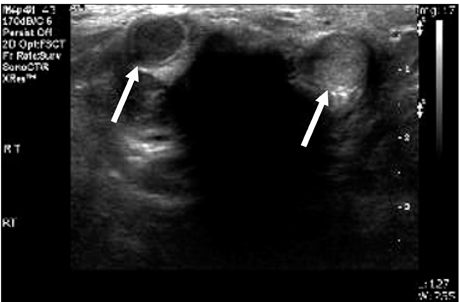World J Mens Health.
2013 Aug;31(2):179-181.
Intrascrotal and Extratesticular Multiple Schwannoma
- Affiliations
-
- 1Department of Urology, Jeju National University Hospital, Jeju National University School of Medicine, Jeju, Korea. urohjs@jejunu.ac.kr
Abstract
- Schwannoma, which may occur in any region of the body, is very rare in the scrotum. Schwannomas are tumors that originate from Schwann cells and, theoretically, could affect any nerve. In spite of the rich innervation of the genital area, these kinds of tumors are not common in the scrotum. A 67-year-old man visited our hospital for investigation of a 2-year episode of multiple slowly growing masses in the scrotum. Testicular tumor markers were within normal range (beta human chorionic gonadotropin <5 mIU, alpha-fetoprotein : 4.86 ng/ml). Scrotal ultrasonography revealed intrascrotal and extratesticular masses in the mid-scrotal region. Complete excision of the scrotal masses was performed. After surgery there was no testicular invasion. Histological examination of the resected specimen showed them to be schwannomas of the scrotum. We report one case of multiple schwannomas of the scrotum with a review of the literature.
Keyword
MeSH Terms
Figure
Reference
-
1. Arciola AJ, Golden S, Zapinsky J, Fracchia JA. Primary intrascrotal nontesticular schwannoma. Urology. 1985; 26:304–306.
Article2. Fernandez MJ, Martino A, Khan H, Considine TJ, Burden J. Giant neurilemoma: unusual scrotal mass. Urology. 1987; 30:74–76.
Article3. Chan PT, Tripathi S, Low SE, Robinson LQ. Case report-ancient schwannoma of the scrotum. BMC Urol. 2007; 7:1.4. Oberman HA, Sullenger G. Neurogenous tumors of the head and neck. Cancer. 1967; 20:1992–2001.
Article5. Asthagiri AR, Parry DM, Butman JA, Kim HJ, Tsilou ET, Zhuang Z, et al. Neurofibromatosis type 2. Lancet. 2009; 373:1974–1986.
Article6. MacCollin M, Chiocca EA, Evans DG, Friedman JM, Horvitz R, Jaramillo D, et al. Diagnostic criteria for schwannomatosis. Neurology. 2005; 64:1838–1845.
Article7. Giglio M, Giasotto V, Medica M, Germinale F, Durand F, Queirolo G, et al. Retroperitoneal ancient schwannoma: case report and analysis of clinico-radiological findings. Ann Urol (Paris). 2002; 36:104–104.
Article8. Safak M, Baltaci S, Ozer G, Türkölmez K, Uluoğlu O. Long-term outcome of a patient with intrascrotal extratesticular malignant schwannoma. Urol Int. 1998; 60:202–204.
Article9. Safak M, Baltaci S, Yaman S, Uluoğlu O, Eryilmaz Y. Intrascrotal extratesticular malignant schwannoma. Eur Urol. 1992; 21:340–342.
Article
- Full Text Links
- Actions
-
Cited
- CITED
-
- Close
- Share
- Similar articles
-
- Intrascrotal and Extratesticular Schwannoma: A Case Report
- Mesenchymal Chondrosarcoma Arising from the Intrascrotal Extratesticular Soft Tissue: A Case Report
- Intrascrotal Extratesticular Epidermal Cyst
- Multiple Epidermoid Cysts Arising from the Extratesticular Scrotal, Spermatic Cord and Perineal Area
- Smooth Muscle Hyperplasia of the Epididymis: Report of A Case and Review of the Literature



